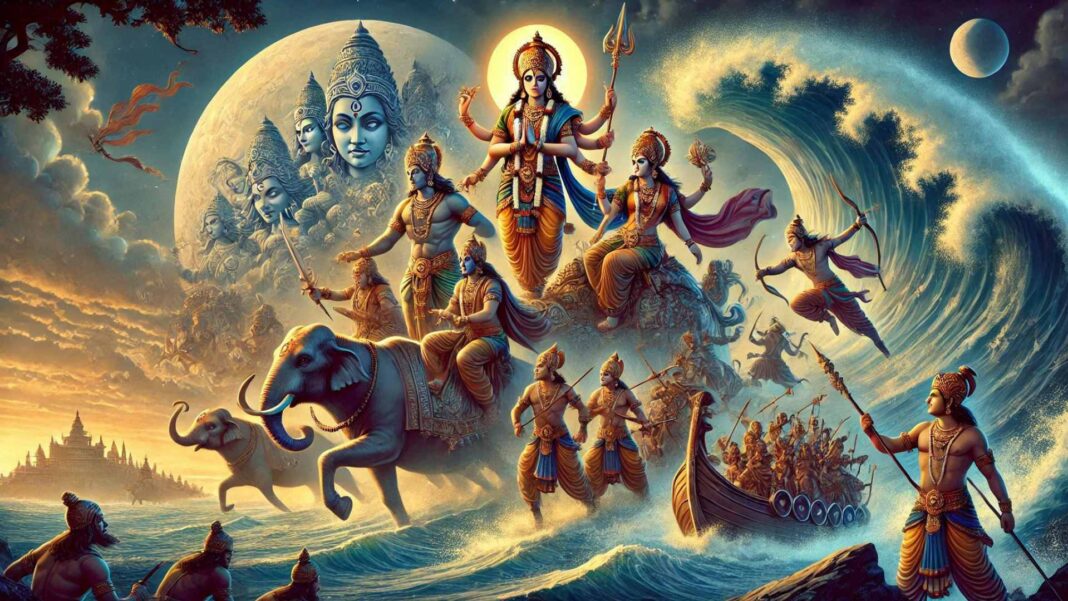Elements in Hindu Worship: Exploring Sacred Foundations
Hook Statement:
Have you ever wondered why fire, water, sound, and even sacred texts hold profound significance in Hindu rituals? These elements are not mere symbols—they are bridges to the divine.
Brief Overview:
Hindu worship, or puja, intricately combines natural and metaphysical elements to create a pathway to spiritual awakening. The sacredness of these elements, drawn from foundational texts like the Vedas, Upanishads, Bhagavad Gita, and Epics, reflects a deep understanding of cosmic interconnection.
Read More About sacred texts
Historical Significance:
The sacred elements in Hindu worship—fire (agni), water (jal), sound (shabda), and sacred texts—date back to the Vedic period, around 1500 BCE. These components not only signify devotion but also represent cosmic principles essential to maintaining harmony in the universe.
Modern Relevance:
In today’s context, these elements provide spiritual grounding, helping people navigate modern challenges with wisdom, mindfulness, and a sense of universal oneness.
2. Historical Background
Origins in Mythology:

- The Vedas introduce fire (agni) as the medium between humans and gods, facilitating yajnas (sacrificial offerings).
- The Upanishads reinterpret these elements as metaphors for spiritual knowledge and inner transformation.
- The Puranas and Epics recount stories like the churning of the ocean (Samudra Manthan), highlighting the sanctity of water and divine intervention.
Evolution Through Time:

- Vedic Period: Rituals centered on fire and sound, with hymns chanted to invoke deities.
- Post-Vedic Period: The Upanishadic era introduced meditative practices and the symbolic use of elements.
- Bhakti Movement: Worship became more personal and accessible, with elements like flowers, lamps, and holy water taking center stage.
- Modern Era: Simplified rituals have evolved for home worship and global Hindu communities.
Regional Variations:
- South India: Elaborate temple rituals with water (abhisheka) and fire lamps (deepam).
- North India: Focus on sound through bhajans and aarti in daily worship.
- East India: Rituals involving natural elements during Durga Puja.
3. Spiritual Significance
Religious Importance:

Each element in Hindu worship represents a facet of divine presence and universal truth.
- Fire (Agni):
- Regarded as a purifier and messenger to the gods.
- Central to Vedic yajnas and temple ceremonies.
- Water (Jal):
- Represents life, cleansing, and sanctity.
- Used in rituals like abhisheka (bathing deities) and tarpana (ancestral offerings).
- Sound (Shabda):
- Mantras like the Gayatri symbolize the cosmic vibration.
- Om, the primal sound, connects practitioners to Brahman (ultimate reality).
Symbolic Meaning:
- Fire: Represents energy, transformation, and divine light.
- Water: Embodies purity, sustenance, and renewal.
- Sound: Connects the physical and spiritual realms through vibrational resonance.
Connection to Deities:
- Fire is associated with Agni and Shiva.
- Water rituals honor Varuna, Ganga, and Lakshmi.
- Sound invokes deities like Saraswati (knowledge) and Vishnu (cosmic balance).
Role in Hindu Philosophy:
The sacred elements reflect the five cosmic principles (Pancha Mahabhuta)—earth, water, fire, air, and space—emphasizing interconnectedness.
4. Practical Application
Use in Worship:

- Fire: Central in aarti, yajnas, and homa ceremonies.
- Water: Integral to abhisheka, temple rituals, and pilgrimages (bathing in rivers like the Ganges).
- Sound: Essential in chanting mantras, reciting scriptures, and performing bhajans.
Daily Practices:
- Lighting a lamp (deepam) to invoke divine presence.
- Sprinkling water for purification before rituals.
- Reciting verses from the Gita, Vedas, or Upanishads.
Rituals and Ceremonies:
- Yajna: Fire offerings accompanied by Vedic chants.
- Temple Worship: Combining all elements in a sacred space.
- Festivals: Holi uses water for symbolic cleansing; Diwali celebrates fire as light overcoming darkness.
Modern Adaptations:
- Virtual pujas and online mantra sessions.
- Eco-friendly practices like using biodegradable items in rituals.
Home Worship:
Simple altars with lamps, incense, water bowls, and scriptures allow individuals to perform daily pujas.
5. Cultural Impact
Influence on Society:
- The elements reinforce ecological awareness and harmony with nature.
- Rituals bring communities together, fostering shared spiritual experiences.
Art and Literature:
- Sacred elements inspire classical music, dance, and visual arts.
- Epics like the Ramayana and Mahabharata feature fire, water, and sound prominently in key events.
Festival Connections:
- Diwali: Lamps signify inner light and victory of good over evil.
- Kumbh Mela: Pilgrims bathe in sacred rivers to cleanse sins.
- Navratri: Worship involves all elements—fire for aarti, sound for devotional music, and water for purification.
Regional Customs:
- Kerala’s temple festivals incorporate firework displays and water processions.
- Bengal’s Durga Puja culminates in immersing idols in water, symbolizing return to nature.
Contemporary Relevance:
These elements resonate globally, with practices like yoga and meditation gaining popularity across cultures.
6. Conservation/Preservation
Current Challenges:
- Overuse of resources like water in rituals.
- Pollution from non-biodegradable materials during festivals.
Preservation Efforts:
- Promoting eco-friendly practices, like clay idols and natural dyes.
- Initiatives to revive Vedic chanting traditions and temple conservation projects.
Environmental Aspects:
The sacredness of rivers, forests, and mountains in Hinduism emphasizes environmental protection.
Community Initiatives:
- Groups like ISKCON focus on sustainable worship practices.
- Government efforts to clean and protect the Ganges.
Future Outlook:
Greater awareness of sustainable practices ensures the survival of rituals and their harmony with nature.
7. Expert Insights
Quotes from Scholars:
- Swami Vivekananda: “Each element in worship serves as a link between man and the infinite cosmos.”
- Dr. Radhakrishnan: “The Vedas and Upanishads teach reverence for the natural world, reflected in every ritual.”
Scientific Research:
- Studies on mantra chanting reveal its ability to reduce stress and enhance focus.
- Fire and water rituals are being explored for their meditative and communal effects.
Modern Interpretations:
Spiritual leaders like Sadhguru and Sri Sri Ravi Shankar emphasize the universal applicability of these elements in achieving inner peace.
Expert Opinions:
- Scholars advocate for aligning traditional practices with ecological sustainability.
- The global Hindu diaspora continues to reinterpret worship elements in contemporary settings.
8. Conclusion
Summary of Key Points:
Sacred elements in Hindu worship—fire, water, sound, and texts—serve as conduits to the divine. Rooted in ancient wisdom, they remain relevant in modern spirituality, blending tradition with adaptability.


